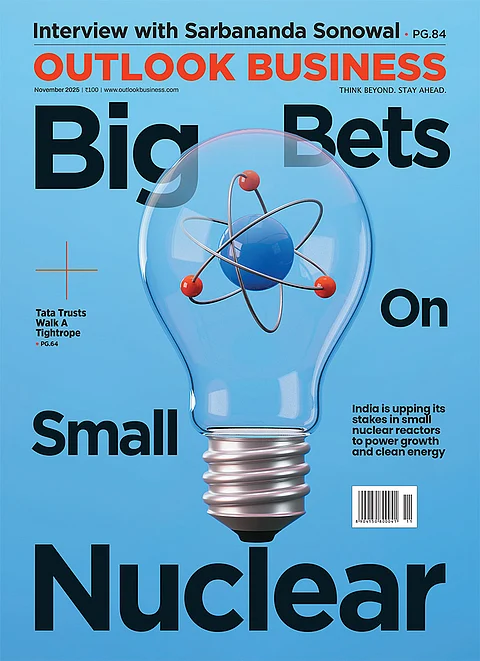Resilience. Undoubtedly, it was one of the most used terms by Dalal Street analysts this year. Be it when the markets were touching record highs or witnessing a steep decline, the sentiment of the street remained largely positive as domestic investors (DIIs) became the new market movers. On top of that, narrative stocks added to the euphoria.
Railways, Defence and PSUs became the new multibagger sector delivering robust stock returns. And while the narrative kept the investor mood high, the profit-booking that followed took away the market exuberance. But not more than what geopolitical tensions, subdued macro indicators and a quiet Q2 performance of India Inc. combined did.
Not ignoring, the central bank's interest rate play.
As of now, none of the above-mentioned sectors are among the top performers this year. Big railway players like IRFC and RVNL have dropped by about 30 per cent from their all-time highs. Likewise, major defence stocks have also been on a downward trend. The PSU space is no different as the sectoral index, BSE PSU has declined by nearly 15 per cent from its peak.
So far, the performance picture of the domestic market doesn't look great, right?
However, major defence stocks like Mazagon Dock, Cochin Shipyard and railway stocks like RVNL continue to be multibaggers, delivering triple-digit year-to-date returns. The BSE PSU index has surged over 21.4 per cent on year-to-date (YTD) basis, far outpacing the single-digit return of benchmark Sensex (8.8 per cent as of December 28).
What does that tell about the market?
Stay for long? Is timing king in the market?
Maybe. But one of the major things these contrasting returns point out is the narrative play in the market. A June report by Kotak Institutional Equities mentioned that "narrative stocks" are priced more on stories or expectations than on solid financial performance.
"The mind-boggling market caps of many ‘narrative’ stocks relative to their fundamentals raise the mind-numbing issue about the future of the stocks and investors (and other stakeholders). It is obvious that somebody will still be holding the shares, if and when such stocks were to trade at ‘fair’ valuations, based on their fundamentals," the report stated.
But what is indeed driving the stock prices above even at a time when caution remains the larger call of D-street analysts is none other than liquidity.
Money continues to flow
"The primary factor driving the market now is liquidity," Deepak Ramaraju, Fund Manager at Shriram AMC told Outlook Business in an interview. "If we talk about today’s investors, they have higher return expectations, which fuels more investment in equities. Then massive flows from instruments like National Pension Scheme (NPS) and Employees' Provident Fund (EPF) is also adding to the already high levels of liquidity in the market," he further added.
Liquidity seems to be abundant in the market. Be it through SIPs or initial public offerings (IPOs). While SIPs have already surpassed the Rs 25,000 crore level mark, the total mutual fund assets surged by Rs 17 lakh crore in 2024, reaching Rs 68 lakh crore by November-end. This marks an increase of 33 per cent from Rs 50.78 lakh crore reported last year.
As for the primary market, some of the biggest IPOs, like Hyundai Motors and NTPC Green, made their D-street debut this year. According to a report by Pantomath, during the first 11 months of 2024, nearly 76 companies raised around Rs 1.3 trillion. In terms of the volume, India hosted twice as many initial share sales as that of the US. Even fundraise methods via Qualified institutional placement (QIPs) witnessed over 90 deals, raising a record Rs 1,29,200 crore.
Besides this, promoters selling their stake in subsidiary companies, as happened in the case of Whirlpool Corp, also added to the bulk liquidity. And let's not forget the unrequited love of retail investors: SME IPOs, wherein a company planning to raise just Rs 8 crore received bids of over Rs 1000 crore.
While this might look puzzling and a meme-piece for D-street players, this altogether made the task of finding undervalued opportunities in the market difficult. "Fund managers may be forced to explore riskier assets or unconventional market opportunities (Grey market). Plus, the excess liquidity in the market could lead to inflated asset prices, which could reduce the prospects for gains," Ravi Singh, SVP of retail research at Religare Broking told Outlook Business.
As the money keeps flowing in, the resilience of the Indian stock market surely remains at peak. Despite the Federal Reserve's cautious pace of rate cuts and faltering Q2 macro indicators driving away FIIs, domestic investors emerged as the 'saviours' of the market. To put a halt to this frenzy, the market watchdog brought in multiple policies, including limiting expiries under F&O measures and tightened rules for SME IPOs.
But all-in-all, 2024 remained quite an eventful year for markets. With drastic ups and downs, the trajectory signaled a lot about the sentiment play.
Even during parliamentary elections, when exit polls indicated a grand victory for the NDA government, the markets surged over 3 per cent but only to decline by around 6 per cent the day after when the actual results came in. The stock market experienced one of its biggest single-day fall during that time.
While the mood of the market has always played a big role in fluctations, what the D-street witnessed during mid-year election was perhaps one of the biggest impacts yet.
However, the market was easily able to surpass its past all-time-highs even after that. The first-half of the year was definitely a time when the music continued to play for investors.
The tale of two halves
Overall, 2024 turned out to be a positive year as Nifty registered its ninth consecutive annual gain. The market performance remained robust despite challenges such as geopolitical tensions from two ongoing war (Israel-Iran and Ukraine-Russia), Japan's unexpected rate hike and lingering recession fears in the US as the tech-heavy Nasdaq slipped into correction territory.
The Indian stock market was quite easily able to erase the impact of tensions which was quite visible when the domestic benchmark indices touch new all-time-highs.
"The first half of the year saw robust corporate earnings, a surge in domestic flows, and a resilient macro landscape, driving the Nifty to an all-time high of 26,277 in September 2024. In fact, the markets navigated significant events, such several global geo-political issues, General Elections and Budget in India, and any dips were swiftly met with strong buying activity," Motilal Oswal wealth management stated in its 2025 Outlook report.
However, in the last 2 months, markets witnessed a significant correction, marking the third major decline since the covid 19 pandemic in 2020, to be more precise. From valuation concerns and slower-than-expected pace of rate cuts to FIIs selling more than Rs 1.5 lakh crore in the October-November period (highest-ever two month sell-off) and subdued Q2 performance, the reasons were quite apparent. Even the lower GDP figure of 5.4 per cent added to the pessimism.
"Earnings moderation and elevated valuations in mid-caps and small caps, along with a strengthening dollar index after Donald Trump’s election victory, led to FIIs shifting away from India," the wealth management firm added. Yet many D-street players called the 'correction' as healthy.
In both halves, what remained intact was investor expectations around the market's 'resilience.'
As 2024 comes to an end, we might not see a strong 'Santa Claus' rally as seen in the past, but the sentiment play of markets this year has proved that there has been a major shift in customary trends. The abundant liquidity might be a problem but it is also a signal that domestic investors are now the major market movers and when do not go well, this cohort will not fall into irrational exuberance as was evident in the last two months.






























